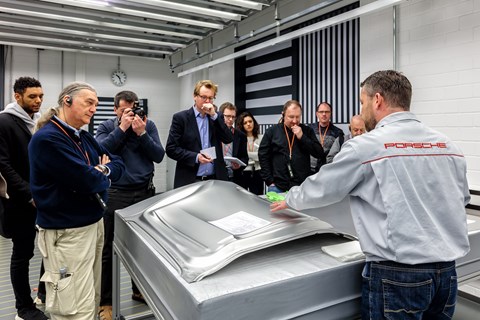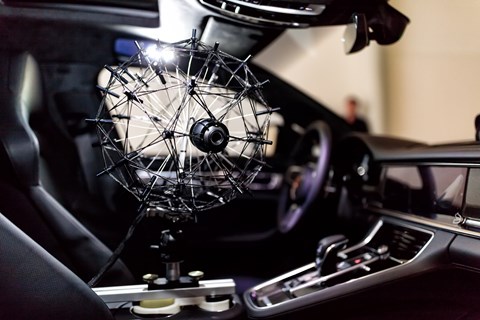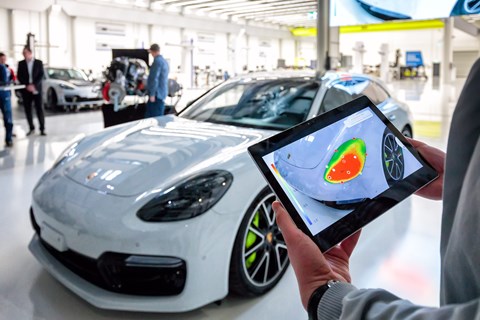► Innovation in Leipzig
► AR and VR used to improve colloboration and quality control
► Will eventually be used in all production
Porsche might be known as one of the most legendary sports car makers in 2018, but it wants to be equally known for the quality of its products. From colour-matching interiors to panel gaps, Porsche wants to be the best on track, and the most impressive when it comes to craftsmanship, too. The boffins in the R&D department dub it Strategy 2025, and it aims to make quality a core pillar of the Porsche brand.

For the past 70 years, achieving a Porsche-approved level of quality has been a time-consuming, laborious process. Craftsmen examine body panels, using chalk and bespoke woollen gloves to perform a ‘haptic inspection’. Undercoated body panels are looked at in the light, with special lines in brightly-lit rooms used to determine that their reflections show no flaws. And eight times a year, a Panamera or Macan chassis is pulled apart, with Porsche engineers dissecting every inch to make sure its 8000 bonds and joints are as strong and stiff as intended.
Those are just a few of the processes that have been at work for decades, but now Porsche is looking to technology for faster, more efficient ways of achieving more even accurate monitoring. CAR went to Porsche’s Leipzig plant to investigate.
The Inno-Space: Porsche’s secret R&D test lab
Located in Saxony, Germany, Porsche’s Leipzig factory represents the efficient, innovative twin of the brand’s Stuttgart home. Notable for its ‘upturned cone’ of a customer centre building, Leipzig has been home to some of Porsche’s most important cars, from the high-volume Macan and Panamera, to the incredibly small production numbers of the Carrera GT.

Over the years, the Leipzig plant has continued to grow to meet new demands, and now it’s also home to the Inno-Space, Porsche’s ‘skunkworks’ project that’s using tech like VR and AR to improve quality in manufacturing. Pitched as an incubator for new ideas and industrial methods, it’s able to work with universities and other technology partners.
What is it?
Unlike other R&D departments, the Inno-Space sits alongside the actual vehicle production line, and that means ideas can be developed and tested in a controlled way. The result? Some innovations get to prove themselves in a realistic environment, while others get to be developed and tested continuously until they meet the demands of an actual production facility.
‘In the Inno-Space we can design and test pioneering concepts for the future without disrupting the plant’s normal processes,’ says Albrecht Reimold, board member for production and logistics at Porsche.
What are the actual innovations?
During a tour of the new Inno-space, Porsche showed CAR a variety of innovations it’s already planning to use in series manufacturing. First we’re shown a Polegis, a simple but highly effective geo-location app that’s able to track the movement of every chassis through the plant.

After that, Porsche engineers explain how they’re using Oculus Rift and HTC Vive to aid collaboration. Both headsets cover the entire head and are able to project the user to a separate virtual location, complete with 3D CAD models of any particular component they want to look at. Once loaded into the environment, users are able to grab, expand and even slice through any virtual parts.

For Porsche’s Leipzig factory, this has some key business advantages. Significantly, parts for the upcoming co-developed Bentley Continental GT are also manufactured at the factory, and VR offers a way for Bentley and Porsche engineers to have virtual meetings with each other. Using the the headsets, engineers can virtually discuss, measure and even annotate parts in 3D – despite being on opposite sides of the continent.
Tell me about acoustic fingerprinting
After new cars leave the production line, they’re shaken down on Porsche’s short but demanding test course, with each test driver noting everything from interior noise to handling issues. However, a new process called acoustic fingerprinting could speed up that sign-off significantly.
Porsche has used high-end microphones to build up a sonic picture of what a Panamera or Macan interior should sound like when driven over typical roads. When a car is tested and the frequencies don’t match up, the new system shows where the anomalous sounds are coming from – making it quicker and easier for human engineers to find, identify and fix the problem.

While it might not be viable right now, when autonomous cars are more prevalent in the future, acoustic fingerprinting could be completed without a human in sight. Cars could drive pre-programmed routes, and if no faults are found, Porsche engineers needn’t be involved. That’s the robot economy, right there…
The rig used is currently the size of a beachball, but Porsche says it’ll be the size of a tennis ball by the time it reaches proper use.
Why Porsche is using a HoloLens to make its cars better
The last and most sci-fi of all the innovations has to be Porsche’s use of augmented reality. Unlike virtual reality, which replaces your view with an entirely made-up one, augmented reality essentially overlays computer-generated images on top – just like the film Minority Report. The tech is used in videogames to drop bizarre creations into the real world, but Porsche will use it to identify faults in parts.

The idea is actually rather simple. A Porsche engineer wears an AR headset preloaded with a CAD drawing of whatever part they’re looking at. Once calibrated with the physical part in real life, the engineer’s HoloLens can virtually annotate it, revealing information about each connection and each joint. What’s more, the HoloLens’s ability to overlay the CAD during with the real thing shows any areas of discrepancy.
Porsche also showed us a tablet app which used a camera and CAD data to do a similar thing – only without a headset. Using something similar to a heatmap, it was able to show areas that were identical to what Porsche intended and parts that were more than 0.5mm out – Porsche’s maximum margin of error.

The future of manufacturing, Porsche-style
Does technology make building cars less special, you ask? In a word; no. While human craftsmanship will always be an integral part of Porsche production (or any premium car brand for that matter) technology still has an important role to play. From perfectly colour matching displays in cars, to speeding up the quality control process – with even more accuracy than a human – tech is only going to be more prevalent in the production lines of tomorrow, and the cars that roll off them.
Porsche says that a few of its Inno-Space products, such as the geo-location app, are already being used, and it’s only a matter of time before more exotic AR-based methods also find their way to the production line.